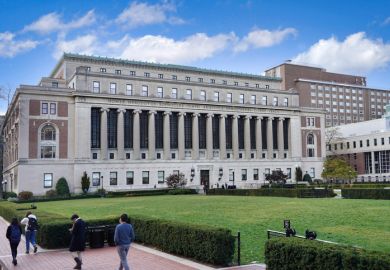Source: Getty
Magnetic attraction: graduates are drawn to places with highly educated workers
The gap between university graduates and less well-educated people is no longer only economic. It is becoming geographic, as those with degrees migrate to cities with high housing prices and living standards, while those without drift to more affordable but less desirable smaller cities and the countryside.
That is the conclusion of a report by an assistant professor of economics at the Stanford Graduate School of Business, whose study of the phenomenon in the US evokes the image of science-fiction films in which future cultured elites inhabit shiny urban meccas while the rest of society is left to wallow in squalid conditions just outside the walls.
In fact, said Rebecca Diamond, the author of the policy brief for the Stanford Institute for Economic Policy Research, “I don’t think we could ever go to those kinds of extremes. There’s always going to be demand for low-skilled work, even in these cities.”
But her research shows that university graduates are being drawn to thriving cities with more cultural institutions, better restaurants, less crime and a host of other desirable amenities. This drives up the cost of housing in them even higher – and drives out workers whose wages do not keep pace.
“We could have more segregation on this margin where, because of housing prices, the nicest places accrue to the educated,” Dr Diamond said.
Better living for the better educated
In the US, it is already true that the income disparity between university graduates and those with only a secondary-school diploma has nearly doubled since 1980, rising from 38 per cent to 73 per cent today.
But that statistic does not give a full picture of the gulf between people with degrees and those without, Dr Diamond said. Also growing quickly is what she calls “economic well-being inequality”, which she defines as the comparable availability of such things as upmarket dining and shopping and low rates of crime.
This economic well-being inequality, Dr Diamond calculates, increased by 67 per cent between 1980 and 2000, the period she has studied most closely using available census data. That means that it has grown faster than the wage gap during the same time.
“The welfare effects of changes in local wages, rents, and endogenous amenities led to an increase in well-being inequality between college and high school graduates which was significantly larger than would be suggested by the increase in the college wage gap alone,” she writes in the report.
No city for old working-class men
This acceleration, Dr Diamond argues, is fuelled largely by changes in labour demand in urban areas as their economic bases shift from manufacturing to technology, which requires highly educated workers.
And it is likely only to get worse, Dr Diamond said. If the trend continues, “you’re going to see even more segregation, more disparity in housing prices, and the nice places that are the biggest cities in the United States are going to be harder places to live in”.
Dr Diamond studied working Americans aged 25 to 55 in 218 metropolitan areas.
She found that places where high proportions of university graduates were already clustered, such as Boston and San Francisco, continued to attract more graduates while smaller cities with less-well-educated populations did not.
The cycle is self-perpetuating. Every 1 per cent rise in a city’s ratio of university graduates to those without tertiary education increased its housing price by six-tenths of a percentage point, Dr Diamond found. That has shut out low earners while, at the same time, attracting still more higher earners to places with the greatest advantages.
Although it was not explored in her research, the geographic segregation of Americans could exacerbate political divisions, among other effects, Dr Diamond said.
But, she continued, several countervailing factors made it unlikely that we would see a dystopian future of completely segregated populations – a world in which the 1 per cent is spatially separated from the 99 per cent – most notably because not just 1 per cent but nearly 40 per cent of Americans have university degrees.
Cities that have failed to attract the educated, Dr Diamond said, can fight back by developing the kinds of amenities that they find desirable or by using tax incentives to lure companies that employ high-skill workers.
Register to continue
Why register?
- Registration is free and only takes a moment
- Once registered, you can read 3 articles a month
- Sign up for our newsletter
Subscribe
Or subscribe for unlimited access to:
- Unlimited access to news, views, insights & reviews
- Digital editions
- Digital access to THE’s university and college rankings analysis
Already registered or a current subscriber? Login





